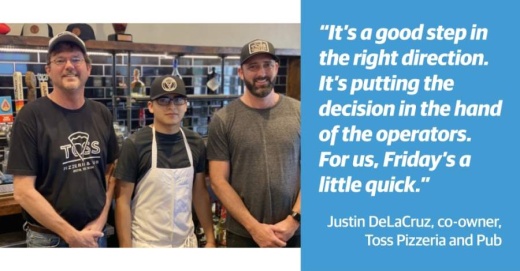When Gov. Greg Abbott announced on April 27 that restaurant dining rooms, movie theatres and malls could reopen their doors to the public on May 1, he emphasized that the state was not mandating anything, but rather allowing business owners to make their own choices.
"This is permission to open, not a requirement," Abbott said during his news conference from the Capitol.
Chris Cunningham and Ali White, the husband-and-wife co-owners of Nervous Charlie's on North Lamar Boulevard, were watching the governor's announcement on TV. They had already upended the business model for the bagel shop once to transition to curbside orders only. Now, a whole new set of questions were going through their heads:
How will the dining room be rearranged? Where will the line go once people have to stand six feet apart? How many people will be let in the restaurant? And most importantly, how is safety for employees and customers maintained?
With so many outstanding questions, Cunningham said May 1 would be too early to open the dining room up to diners again.
"We still think we can overcome this and get that dining room open at a limited capacity. It's just going to take us some time," Cunningham said.
Justin DeLaCruz, co-owner of Toss Pizzeria and Pub, had a similar reaction. Toss, which has locations on South First Street and Bee Caves Road, has been busy with takeout orders since shutting down its dining room, and DeLaCruz said he has not had time yet to put a plan in place to safely reopen the dining room to make customers feel comfortable.
"It's a good step in the right direction. It's putting the decision in the hands of the operators. For us, Friday's a little quick," DeLaCruz said.
Local officials criticized the governor's reopening plan as too much, too fast. Austin Mayor Steve Adler said he was concerned the governor "may have gone too far," and District 4 City Council Member Greg Casar said the plan "has put us on a path toward more coronavirus hospitalizations."
While some restaurant owners agreed that the plan was overreaching in interviews with Community Impact Newspaper, many appreciated the phased approach they would be allowed to take.
"It’s going to be complex, it’s not as easy as just opening the doors," Cunningham said of the reopening process. "There’s going to be new policies, new procedures, each of which we’re going to have to create training manuals for."
Emily Williams Knight is the chief executive officer of the Texas Restaurant Association, which advocates for its members statewide. She said while 25% capacity is not enough to get restaurants back to break-even, it's a strong start.
"We came out very strongly in appreciation of the government’s response. By opening at a 25% threshold he’s balancing the safety and public health with the needs of the economy," Williams Knight said.
Opening for business
Some restaurant owners feel they have the safety measures in place to let customers back into the dining rooms on May 1 while following the governor's orders to limit the number of diners to 25% capacity.
James White opened the Broken Spoke in South Austin in 1964, when he was 25 years old. He said the longstanding honky-tonk bar was having one of its best years in its history before the virus wiped out hundreds of thousands of dollars in revenue. Still, the 81-year-old White said he believes this too shall pass.
"We're kind of used to having choppier waters around here," White said.
The Broken Spoke will open its kitchen May 1 and keep the dining area limited to the mandated 25% capacity while requiring face coverings for its staff and everyone who enters. Dancing and entertainment will have to wait. White said he hopes to have that back as soon as possible and he will "keep his fingers crossed and pray a lot."
"We'll see what happens. Hopefully we get a good crowd, everyone has fun, and we'll get them to come back again," he said.
Pete Clark, owner of Cafe Blue in downtown Austin and Bee Cave along with the Sundancer Grill in Lakeway, said his phone started ringing off the hook when Abbott made the announcement April 27. Clark will open his restaurants May 1 while marking certain tables as closed for social distancing and spreading out dine-in customers to adhere to the 25% capacity.
"I think our bigger problem is going to be keeping people from trying to exceed (capacity limits)," Clark said.
How long can restaurants hang on?
According to a survey by the National Restaurant Association released April 20, 61% of restaurant employees in Texas have been laid off or furloughed since February—representing more than 688,000 employees. A separate study from the University of Houston's Hobby School of Public Affairs found that half of restaurant owners in Texas say it will take their businesses nine months or longer to recover from the crisis, and 3% say they don't expect to ever recover.
Christian Cryder, owner of Lazarus Brewing Company, said he will be taking an extra week to open after the dine-in restrictions lift in order to put safety measures in place for customers, who will be limited to the patio seating only for the East Austin brewery starting May 8.
Cryder said it was important to him to take a thoughtful, measured and safe approach to reopening, and opening at 25% capacity is only the start of the road to business recovery.
"If we think businesses can run on 25% capacity in this market, we're kidding ourselves. It's certainly better than nothing, but we're going to have to get back to 75-80% capacity just to start getting close to break even," Cryder wrote in an email.
Abbott said in his announcement that if public health data shows the virus is remaining contained in Texas by May 18 and the state's hospital resources continue not to show signs of stress, restaurants will be able to open at 50% capacity on May 18.
"25% doesn’t work forever or more than a couple weeks," Williams Knight said. "Let’s do this well to get ourselves to the next phase as soon as possible."
Customer confidence
Restaurant owners who spoke with Community Impact Newspaper agreed that no matter how many diners they let in, consumer confidence will be a key element of recovery, and that means opening safely without rushing or creating an unsafe environment.
Jack Gilmore, the owner of Jack Allen's Kitchen and Salt Traders Coastal Cooking, decided to close his restaurants completely to keep his staff and the community safe. Now, he will roll out a phased and cautious approach—starting with curbside takeout on May 1, followed by opening the dining room a couple of weeks later.
Gilmore said customer safety has to be the top priority, because a resurgence of the virus would be devastating to the restaurant scene locally.
"There are not a lot of restaurants that could close once, let alone twice," Gilmore said.
DeLaCruz, the co-owner of Toss, said he does not know when customers will feel comfortable going out again. For some it may be in a week, for others it may be longer. But what he can control is the safety in his restaurant to make sure whenever that point is, the experience is a positive one that keeps customers coming back.
"There’s going to be a time where people have to decide if they’re comfortable going out to eat again," he said. "People will get to that place at some point. It's going to be (important) they know the systems and the safety are in place."
Brian Rash and Iain Oldman contributed to this report.





